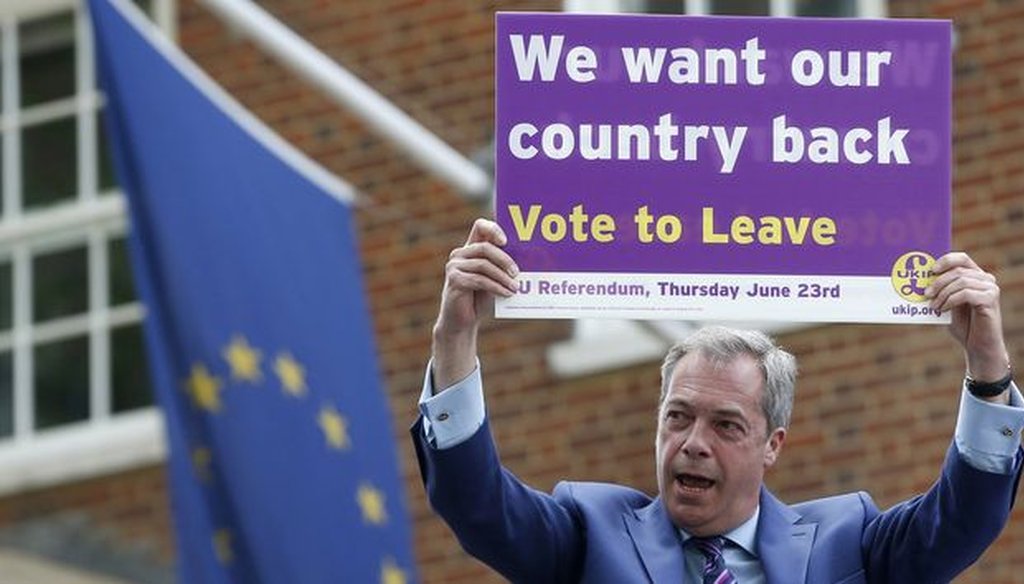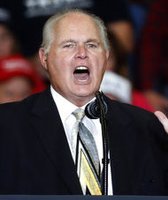Get PolitiFact in your inbox.

British politician and leader of the UKIP party Nigel Farage holds up a placard as he launches his party's campaign for Britain to leave the EU, outside the EU representative office in London. (AP)
Given that "What is the EU?" was a trending Google search after the United Kingdom voted to leave the European Union, Americans rightly still had many questions about the Brexit vote Sunday.
Why did a majority of voters from the United Kingdom vote to leave? What does it mean for Europe, the world, the United States? Could it affect the U.S. presidential election?
PolitiFact can’t answer all of those questions, but we did hear a few specific claims worth fact-checking from the Sunday new shows.
Who was behind the vote to leave
One of the claims we heard was that the Brexit vote was divided largely around the age of the voter. Younger voters wanted to stay in the EU. Older voters cast their ballot to leave. Here’s how U.S. Sen. Tim, Kaine, D-Va., put it.
"Young voters, those under 50, especially millennials, overwhelmingly voted to stay. And it was older voters who voted to leave," Kaine said.
Is that true?
Largely. We rate that claim Mostly True.
The United Kingdom voted to leave the union 52 percent to 48 percent. Usually, journalists and others rely on exit polling to learn about demographic breakdown of votes and also to call the results of an election before all ballots have been counted. However, there were no official exit polls from the Brexit vote, in part because of the difficulty of constructing a good poll on such a rare referendum.
But we did find an unofficial exit poll of more than 12,000 people, conducted by Michael Ashcroft, a British former politician and businessman who also conducts public polls. His Brexit findings support Kaine’s claim.
According to Ashcroft, who supports Brexit, a majority of voters 44 years old and younger voted to remain, while those 45 and older voted to leave. (Kaine specifically mentioned voters 50 and younger, and this is as close as Ashcroft’s poll gets to that bracket.)
Kaine also said millennials were especially enthusiastic about remaining in the European Union, and he’s correct. Those between 18-24 years old voted 73 percent against Brexit, and those between 25-34 years old voted 62 percent to stay, according to Ashcroft’s poll.
That’s in stark contrast to voters 65 and over who voted 60 percent in favor of leaving the European Union.
Ashcroft’s polling is in line with the results of surveys conducted in advance of the vote. "Call your nan!" was a pitch in the last days of the "stay" campaign, pushing youngsters to try and flip their grandparents.
The Wall Street Journal analyzed and consolidated polling from several agencies and found that among those polled, people aged 18-24 opposed Brexit 60 percent, compared to 20 percent in favor, while the rest were undecided or were not planning to vote. Among those aged 24-49, 45 percent wanted to remain, while 39 percent favored leaving.
The balance flipped among older groups, with 48 percent of those aged 50-64 supporting Brexit, while 42 percent opposed. And 60 percent of those aged 65 or older supported Brexit, and just 34 percent wanted to remain in the European Union.
In light of this split, many young people in Britain are now expressing frustration that an older generation has made a monumental decision about the future, yet it’s the younger people who will spend many more years of their lives living with that decision.
The role of immigration in the Brexit vote
Former Labour Party lawmaker David Miliband, who supported the campaign for Britain to stay in the European Union, discussed a key issue around the Brexit vote -- immigration. One of the arguments from the opposing side was that immigrants were living off the British government and its welfare system.
But that’s spin, Miliband said on Meet the Press.
"The major immigration issue was about Poles, and Bulgarians, and Romanians. Other European countries coming to the U.K., (who were) contributing I have to say," Miliband said. "The unemployment rate among Poles in Britain is lower than the unemployment rate among Brits, which itself is very low at 5 percent on the American level."
That claim rates True.
Miliband is certainly correct that an influx of immigrants from countries such as Poland, Bulgaria and Romania -- and their reliance on government services -- was a central theme in the "leave" movement.
He’s also correct that Poles working in the United Kingdom are less likely than natives of the United Kingdom to find themselves unemployed, according to the latest numbers we could find.
Britain’s Office of National Statistics conducts the country’s quarterly Labour Force Survey.
According to Madeleine Sumption, director of the Migration Observatory at Oxford University, in the last quarter of 2015, the unemployment rate for Poles was 3.5 percent, while the national rate stood at 5 percent.
Sumpton cautioned us on the numbers, noting that as in the United States the unemployment rate is based on a survey. Polish immigrants represent a little over 1 percent of the total population of the United Kingdom.
"The numbers hop around a bit from quarter to quarter," Sumption cautioned. That’s due to the small number of Poles in the survey, "but it has always been the case that Poles have lower unemployment than Brits."
The gap has been consistent. We used the labor survey from the first quarter of 2015 and got results similar to Sumption. Further confirmation comes from a 2011 Office of National Statistics report that found Polish unemployment was 5.5 percent back when the overall British rate was 7.8 percent.
While Miliband had his numbers right, his statistic missed one of the major complaints against the Poles -- that their presence makes life harder for the average British worker. When Poland along with seven other Eastern and Central European countries joined the European Union in 2004, the United Kingdom was one of only three nations that allowed the newcomers to come and work immediately.
Over the years, more than half a million Poles arrived. In the 2010 European parliament elections, the pushback in Britain was palpable. The UK Independence Party, a right-leaning group, made immigration control a key issue, running ads that claimed immigrants were driving wages down.
Our fact-checking cousins in the United Kingdom, Full Fact, reported that such complaints had merit. They found that a 1 percent increase in the population of migrants was tied to a drop of .3 percent to .6 percent in wages.
On the other hand, there was no clear relationship to say that immigrants took jobs away from native British workers.
Our Sources
See individual fact-checks.
















































